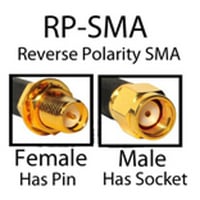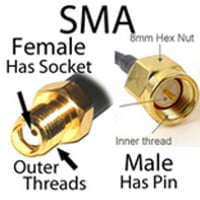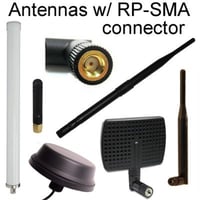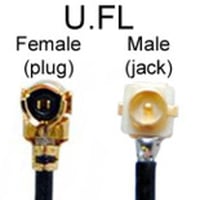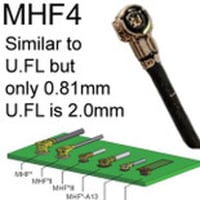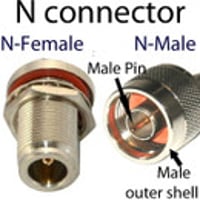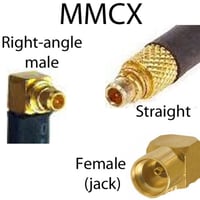Dust Cap Cover for SMA & RP-SMA-female: Nickel w/ O-ring & Rubber versions
- SKU:
- DUSTCAPR
- Availability:
- In stock
- Weight:
- 0.01 LBS
Data Alliance
Dust Cap Cover for SMA & RP-SMA-female
Protective dust cover for SMA-female and RP-SMA female connectors .
Three versions offered on this page:
- Nickel-plated w/ O-ring for waterproofing and dust-proofing: Part# DUSTCAPN
- Nicket-plated with chain
- Rubber version (Red): Dust cover & prevents water intrusion. Part# DUSTCAPR
The nickel-plated version comes with an interior O-ring to completely seal out water and dust intrusion. Nickel-plating is the most robust corrosion protective type of metal plating: It is most effective in preventing corrosive action from rust and a range of other weather and water-related factors.
- The red rubber dust cap is a great economical solution for preventing intrusion of dust and water.
- Diameter of the dustcover: Interior diameter is 6.5mm hole.
- Both the nickel and rubber dust caps are compliant with RoHs 3.
Dust caps for RPSMA and SMA connectors
Dust caps are coverings that are specifically designed and fitted for radio frequency connectors. They are also known as:
- Dust covers
- Radio frequency dust caps
- RF dust caps
- Circular connector dust caps
Dust covers are used to protect the unmated ends of radio frequency connectors, and open terminations of coaxial cable from contaminants that can affect their performance as well as environmental degradation. Applying dust caps to unused ports safeguards the performance of radio frequency equipment, ensuring the accuracy and precision of testing and measurement equipment with signal leakage and interference minimized.
Circular dust caps for RPSMA and SMA connectors.
Our selection of dust caps is designed to fit the SMA and RP-SMA connectors. They will protect and plug these critical radio frequency components, protecting them from physical damage and sealing them from the ingress of dirt, dust, and moisture.
These dust covers are specifically designed to precisely fit Sub Miniature version A (SMA) and Reverse Polarity Sub Miniature version A (RP-SMA) connectors. These sub-miniature-sized threaded connectors are in widespread use in a broad range of radio frequency applications. In particular, the SMA connector is known for its use in cellular networking applications, and the RP-SMA connector is used in wireless networking.
Though the dust caps can be used on both SMA and RP-SMA connectors interchangeably, the SMA and RP-SMA are distinct. The inner mating interface of the RP-SMA is reversed from the standard SMA connector meaning the two connector types cannot mate. The outer body of these connectors, however, is identical and will accept a dust cap of the appropriate dimensions as outlined below.
Dust caps are matched by the gender of the connector.
SMA and RP SMA connectors are made up of male and female connectors and the dust cap selected should be chosen to mate with the complementary gender of the connector. A male dust cap should be used with a female SMA connector and a female dust cap should be used with a male RP-SMA connector.
Quality RoHS and Conflict Mineral Regulation compliant dust caps.
All dust covers and caps provided use materials of good provenance and are manufactured to the highest standard in line with domestic and global legislation and standards. In particular, our radio frequency connector dust caps comply with the following laws:
- The Restriction of Hazardous Substances Directive (RoHS)
- The Conflict Minerals Regulation
- Section 1502 of the Dodd-Frank Act
RPSMA and SMA dust cap physical specifications
There are multiple types of dust caps that are suitable for RP-SMA and SMA connectors. They should be selected according to the harshness of the environment they will be used in. Most are extremely durable. Apart from being specific to connector type and gender, RF dust caps vary according to the following features:
- Material: Metal SMA connector dust covers can be made from the same material as the connectors including brass or stainless steel with gold or nickel plating. Dust caps are also made from thermoplastics, rubber, and silicone.
- Mounting hardware: Coax connector caps have a range of mounting options to prevent the cover from becoming lost when it not in use. Many designs are fitted with fiber, wires, or chains that are installed on the panel or cable assembly. Jack mounting lugs also help when attaching the caps to a connector.
Many metal SMA/RP-SMA dust caps are built to military specifications and provide a fully-compatible, threaded coupling with an O-ring seal or silicone gasket for secure mating to the port. Male RF dust caps for SMA connectors have a diameter of 2.4mm and carry an outer hex nut for tightening the cap with a wrench. They may or may not contain PTFE insulator material at the connector interface, but the gasket acts as the primary sealant. Inside, depending on the type and gender of the subminiature connector dust cap, there may be an inner receptacle or pin. Plastic RP-SMA caps vary in design and usually mate to the connector by simply screw coupling.
RPSMA and SMA dust cap electrical specifications
Radio frequency dust caps are designed to operate across the frequency range of the SMA and RP SMA connector, typically DC to 18 GHz. The peak voltage rating of military specified SMA dust caps will also be comparable to the connector.
Why are SMA and RPSMA dust caps important?
Dust caps are a critical component of many radio frequency circuits and wireless networks as they limit the potential for exposed radio connectors to become damaged. By protecting the connector interface when it is not in use, dirt, dust, and moisture, the primary accelerants of corrosion cannot get into the connector mating interface or threading. Damage to these causes the electrical problems we outline further on, and mean that equipment requires costly downtime and replacement.
SMA and RP-SMA coaxial dust caps can be used wherever these connectors are including sectors such as:
- Testing and Measurement
- Instrumentation
- Control systems
- Satcom
- Telecommunications
- Manufacturing
- Aerospace
- Wireless communications
In industrial settings, they protect radio frequency equipment from heat, dust, oil, and chemical solvents.
SMA connector dust caps provide superior protection from dust
Dust is continually present in the air and has a significant impact on electronic components including radio frequency connectors. Dust is not one material. It is comprised of air suspended solid particles including salts, ions, inorganic minerals (like quartz, felspar, and gypsum), organic matter, and water.
Atmospheric dust, as well as dust that comes from specific industrial activities, can settle on RF connectors and cling to the metal surfaces, threading, and internal mating interface. Dust that is laden with salts as a humectant, drawing moisture from the air and further dust leading to a progressive build-up of this contaminant. Studies on PCBs have shown that the presence of dust increases total water absorption.
On surfaces, adherent dust can lead to the formation of a patina on even the gold or nickel-plated surfaces of the connector. The combination of salt and water leads to the development of corrosion which can progressively deteriorate the connector body and the inner conductor. The physical build-up of dust can impede the proper mating of the connector and also lead to a deterioration in its specified performance, including derangement of the dielectric resistance and contact resistance. Other electrical changes include a loss of surface insulation resistance, electrochemical migration leading to leakage currents, and potentially short-circuiting.
RP-SMA dust covers can prevent corrosion
Corrosion is a process by which metal electronic components such as radio frequency connectors are gradually degraded by reaction with substances in their environment, including salts, dust, and moisture. It is progressive and once started, cannot be reversed. Dust caps prevent moisture and dust from getting to a connector and seal the inner mating interfaces from environmental factors that drive corrosion.
IP rated protection for SMA and RP SMA connectors
IP-rated dust caps and dust covers can assure the safety and performance standard of a cable assembly or circuit. Ingress Protection (IP) ratings or codes are a system of standards developed by the International Electrotechnical Commission (Standard IEC 60529) to specify the level of protection dust caps deliver against the ingress of water and dust. IP codes primarily consist of two digits. The first digit deals with the degree of dust protection of the dust cap and the second digit referring to the protection against liquids.
Common IP codes that refer to coaxial connector caps like SMA or RP-SMA dust caps include:
- IP66 means that a dust cap is dust-tight and able to withstand moisture ingress from sprayed water.
- IP67 means that a dust cover is dust-tight but also protects against moisture ingress if the covered component is immersed up to a depth of 1 meter.
- IP68 dust caps can withstand prolonged (but not continual) immersion.
Dust covers to reduce radio frequency interference
Another benefit of using dust caps is their reduction of electromagnetic interference (EMI). This is critical in almost all wireless applications and especially where precision measurements are required. Use standard and RP-SMA dust caps to both protect and shield networking installations and testing and measurement panels from unwanted noise and radio frequency leakage.
EMI and RFI disrupt the normal functioning of radio frequency circuits. Uncovered connectors and ports can lead to signal leakages that are picked up at the receiver. This is a form of man-made EMI and can cause continuous interference if a connector is left uncovered. RFI generated may be narrowband (which is usually down to an isolated source like an exposed connector) or broadband.
Frequently asked questions about SMA and RP-SMA dust caps.
Are there other methods of protecting radio frequency connectors in situ?
Other products can be used to seal and protect these subminiature connectors. These can be used along with the dust caps or separately. Weatherproofing accessories for connectors and cables are particularly useful for connectors that are used outdoors.
- Cable glands provide high-specification protection for cables and connectors. They are modular conduits made of plastic or metal that are designed to form a sealed outlet for cables that exit enclosures. They also provide IP-rated levels of protection.
- Bulkhead connectors not only provide an O-ring sealed point of connection for the SMA or RP-SMA connector but can also be used for secure mounting on an antenna mount or through the wall of an enclosure.
- Silicone grease can be used to protect the threading and body of these connectors. It is made from thickened silicone oil and is an excellent insulator.
- Silicone tape protects RP SMA and standard SMA connector installations that are outside. This mastic tape can be wrapped around the connector and molded for a waterproof seal.
IN CONCLUSION:
Dust covers are a cost-effective accessory for protecting connectors that are commonly used in radio frequency devices. By protecting your equipment with coaxial connector caps, you can ensure its longevity and improved performance with minimized RFI. This selection of high-quality and durable sub-miniature dust caps for RP-SMA and SMA connectors provide a range of options for properly securing exposed ports and open terminations in deployed radio frequency devices and circuits.
LEARN MORE:

